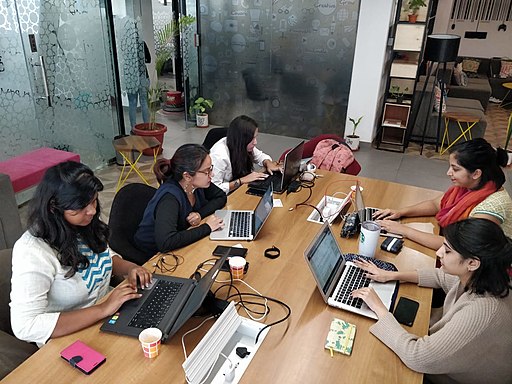Transitioning to a Low-Carbon Future by Embracing Gender Equity
January 30, 2023
Authors
UNFCCC’s 27th Conference of Parties slogan, “Together for Implementation,” spurred India to head to Sharm el-Sheikh with a stronger commitment to the action plan pledge taken at COP26 to become “net zero” by 2070. In addition to the net zero pledge, which includes generating 50% of its energy from renewable resources by 2030, India aims simultaneously to reduce its total projected carbon emissions by one billion tonnes (BBC, 2021). With the deployment of new clean technologies and sustainable practices to assist India on its net-zero pathway, it is imperative to undertake decarbonization while considering broader aspects beyond carbon emission reduction. Transitioning to a low-carbon future by embracing gender equity is not only a technological and financial process but also a nuanced social issue. India, as a developing nation, has opportunities to leverage decarbonization as a platform to embed gender equity into newly-established, clean technology ecosystems and avoid the the replication of structural inequalities that intersect with race, caste, religion, geography, culture, and socioeconomic class.
Gender-Equitable Decarbonization: a Prerequisite
To achieve a low-carbon, sustainable future for India, gender-equitable decarbonization must be a prerequisite. There is potential for India to create a gender-equitable workforce while transitioning towards clean technology, as decarbonization opens green job employment opportunities. Creating a gender-equitable workforce does not only mean increased participation and engagement by women, but also the involvement of women at the climate change policy decision-making level in both industry/business sectors and government. Recent research demonstrates the value of gender equality and higher female participation in the workforce. Up to $28 trillion, or 26%, more might be added to the global yearly GDP by 2025 in a “full potential” scenario in which women’s roles in the labor market are equal to those of men’s (Mckinsey, 2015; ILO, 2020). This is especially true in India, where a sizable percentage of women are still unemployed. Women comprise half of the potential workforce; however, only 25% of the current labor force is female, contributing as little as 18% to the GDP (McKinsey, 2018). Gender-equitable decarbonization can promote economic growth by utilizing the latent potential of unemployed, but eligible, women in the global south (ILO, 2022).

Promoting the participation of millions of potential women workers by expanding employment opportunities in clean technology will boost India’s economy. According to McKinsey, India has the largest relative opportunity in the Asia Pacific to increase its GDP through women’s workforce participation, with the possibility of an 18 percent increase over business-as-usual GDP, or $770 billion. Furthermore, research shows that approaching decarbonization from a gender-equity perspective promotes greater productivity, innovation, and overall facilitates an increase in climate action decision-making (Mavisakalyan et. al., 2019). Adding gender equity to India’s decarbonization efforts would not only establish gender-equitable social structures and economic growth, but also increase the workforce supply as demand increases from new decarbonization jobs.
MSMEs, Gender Equity, and Decarbonization
Indian micro-, small-, and medium-sized enterprises (MSMEs) are providing India with rapid economic growth (aggregated 16-17% towards GDP) along with intensive energy demands creating an inequitable situation for both the climate and the labor force. MSMEs have the capacity to reach USD 1 trillion by the end of 2025 (IBEF) and are a massive employment hub, accounting for around 20% of the country’s workforce in renewable and green businesses, either directly or indirectly. Naturally, these factors make the manufacturing sector highly energy intensive, with its emissions doubling between 2005 and 2013 and a projected upward trajectory (CEEW, 2017). The Bureau of Energy Efficiency indicates that the industrial sector has the highest energy-saving potential, up to 60%, which can be realized by 2030, making it an ideal sector to establish clean technology ecosystems. At the same time, MSMEs in India are notorious for low female employment. Women constitute only one-fifth of the MSME workforce in India (Das et.al., 2014), making it ideal for undertaking gender-equitable decarbonization in Indian MSMEs. The gender bias present in Indian society, as well as lack of workplace environments that are safe, secure, comfortable, and ergonomically designed for women’s involvement, are the main causes of the poor participation of women in India’s manufacturing sector and their engagement with technology. The gender gap is also exacerbated by problems like a shortage of qualified women in the workforce, which can be partly ascribed to social dynamics and gender bias because women are deterred from majoring in technical fields in school and pursuing technical jobs in the workplace.
On a micro level, applying a gender-equitable lens to decarbonization has additional benefits and provides solutions to existing issues at hand for MSMEs. Female employees are known to be more sincere in their work and show reduced attrition and absenteeism. Additionally, from on-ground data (Institute for Sustainable Communities, manuscript under preparation 2023), it was noted that production lines with more female workers had fewer errors in final products. Reduction in attrition, absenteeism, and production errors directly relate to increased productivity and resource efficiency including time and money. Increasing women participation in the workforce could also potentially help tackle the labor migration issue facing MSMEs as half of the untapped hyper local labor found in women could be utilized.
Building a Climate-Resilient, Green Workforce
Increasing the number of women workers in the clean technology field gives India an opportunity to form a stronger, climate-resilient green workforce. Additionally, gender equity in industries unlocks a plethora of co-benefits, including better workplace conditions, increased productivity and creativity through diversity, and resistance to risks such as labor migration and skill shortages. Surveys and on-ground data showed that assembly lines in production with higher women workers had fewer errors in final products, which translates to less waste and reduced use of resources for correcting errors. Around 85% of MSME owners said that women have far less attrition rates than men. For Indian manufacturing industries to undergo gender-equitable decarbonization, three components are necessary: 1) gender sensitization, 2) (green) skilling, and 3) the establishment of women-friendly work environments.
- Gender sensitization: In India’s society, gender biases remain deep-rooted and even normalized, especially in rural and off-city areas. The majority of MSMEs are located in these areas; hence gender and other social biases are largely prevalent. To begin the establishment of gender-equitable ecosystems, gender sensitization of the SME owners and managers, the existing workers (men and women both), the families or the workers, and in a larger context, the local communities, is a requirement. This could be achieved through gender sensitization training programs, using creative tools like story-telling, role reversal, etc. With ESG and responsible business compliances gaining some traction among large companies, medium enterprises, which are the direct suppliers, have to go through social audits, encouraging in-house trainings to increase equality. But for further penetration of such sensitisation programs to small and micro enterprises, civil societies and government initiatives need to be accelerated. These must not be restricted to only factory employers and employees but need to be furthered to communities and local colleges and schools
- Skilling: There is a dearth of women with high-productivity skills and qualifications that would place them in positions of leadership and decision-making roles. STEM subjects have traditionally been focused on men, and women are discouraged from studying subjects that would lead to jobs in related fields, which are considered masculine jobs. STEM education, along with an understanding of economics and social sciences, is important for women to become part of equitable climate action and decarbonization processes for newly unlocked job positions like those of sustainability analysts, auditors, low-carbon operations strategy experts, gender welfare officers, gender equity strategists etc. At the same time, women need to be skilled in working with clean technology, maintenance, and repair for increased participation in the clean technology sector and factory floor levels.
- Conducive work environment: For gender-equitable decarbonization, MSMEs must have a safe, secure, and conducive environment for women to work in. This not only means increased safety, tighter security, and availability of basic amenities like clean toilets and facilities like creches, but also ergonomic considerations of women when buying machinery and new equipment, transportation for night shifts, and appropriate workplace policies for women.
Gender-Equitable Manufacturing
From a consumer perspective, it is possible that the inclusion of specific gender equity criteria throughout the manufacturing process can help give product differentiation. As consumers are becoming increasingly aware of the social and moral impacts of their consumption, they are more likely to conduct research on companies and where to spend their money. For example, consumers want to buy garments that are made without exploitation of workers and/or child labor and are also manufactured using eco-friendly raw materials. Pushback on this issue from customers made large brands like Zara and Primark pay more attention to the working conditions and materials used in their supply chain. Similarly, with the increase in awareness about gender equity, consumers want to be associated with organizations, companies, and brands that are gender equitable. Ensuring a gender-equitable manufacturing process has the potential to provide an edge to Indian manufacturing MSMEs, in terms of readiness and competitiveness, both in the national and international markets.
A standard that establishes a gender-equitable manufacturing process, including significant participation from women in a positive working environment, for MSMEs and validates that products were manufactured in accordance with it could help customers identify and choose these products over others. Such a standard benefits both brands and manufacturers, as customers may be ready to pay premiums for products that satisfy their social responsibility requirements. The possibility of this novel initiative could help establish a business case for companies to increase their commitment to the social component of ESG standards while simultaneously benchmarking consumers’ desire for products that are not only green but gender-equitably manufactured.


